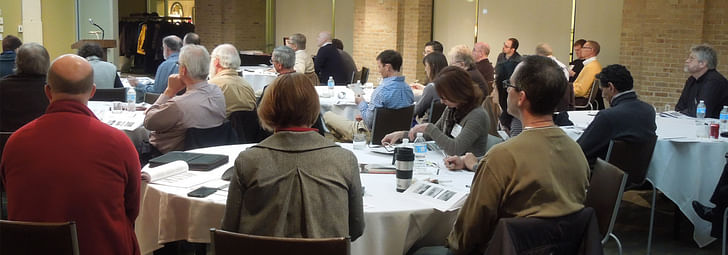

What are continuing education credits, and why are they necessary? More importantly, what’s the easiest way of completing them? For your convenience, we've put together an overview of the AIA's Continuing Education System, and seven simple solutions for getting through it.
In the U.S., continuing education credits help an architect remain registered to practice within a particular state once they have already attained their license; they do not contribute to earning one’s license. Depending on which state(s) you’re registered to practice architecture in, and what professional organizations you may belong to, the number of credits will vary. However, if one fails to complete the number and type of credits within the state’s 1-3 year time frame, your registration for that state will expire, which is never good news.
Many architects knock out all of their requirements at once by attending lectures at the annual AIA national convention. However, for those architects registered in multiple states, keeping track of and fulfilling all their required CE credits can be a kind of master class in of itself. For example, if you complete four units of CE, can that CE be applied to multiple states, or is it only good for one? For clarity on this issue, I asked Steve Tanner, membership director over at the Los Angeles chapter of the AIA, and he told me the following:

“There’s a wide range of requirements across the country in terms of number of learning hours and subject matter. California requires five hours of continuing education every two years for architect license renewal, and they must all be in the topic area of ADA/accessibility. New York requires 36 hours every three years, 24 of which must be in the subject area of Health, Safety and Welfare. If architects are members of the AIA, they also need to fulfill a continuing education requirement of 18 hours per year (including 12 hours of HSW), to maintain their membership.
Fortunately, [Continuing Education System] activities can count towards more than one license renewal: for example, if you’re licensed in three states, and they require 24, 12 and five hours per renewal period respectively, you should theoretically be able to complete 24 hours that cover you for all three states—as long they satisfy any content requirements specific to certain states. The challenge for licensed architects is to keep track of the similarities and differences between states in terms of content areas and renewal deadlines. Timing is crucial, since a course completed outside a state’s reporting period will not be accepted for credit.”
So what are the easiest ways to complete your CE? Here are a few tactics:
1. Visit the AIA Course Directory at AIA.org/education
AIA members and guests can view available classes by subject matter with a few clicks and drop down menu selections. The website will generate a list of courses that match those descriptions as well as the geographic area where the classes are being held. In some cases, classes are only held during certain seasons or times, or may be available to AIA members only.
2. Take online quizzes based off the material in Architect magazine
Finally, proof that pleasure reading does pay off: in this case, you can earn a few CE credits just by passing an online quiz about the articles and material featured in Architect magazine. The quiz can be accessed here.

3. Go to the AIA's national and local conventions
As mentioned earlier, many architects attend the AIA National Convention not just for the keynote speakers, but for the wealth of opportunities it provides to satisfy your CE requirements. Make sure to also check out your local AIA conventions, which may also have CE offerings.
4. Contact your local AIA chapter for CE opportunities
The AIA is composed of numerous local and state chapters all across the U.S., each of which is staffed with intelligent, informed, and enormously helpful people like Steve Tanner. Feel free to give them a call/email and find out about local CE opportunities and requirements.
5. Make up your own CE
Some states will allow you to apply your volunteer, guided tour, or study/research activities toward CE credits. If you’re in the habit of leading people around on weekends to check out local sites of note, or creating a project based off personal research, or doing any other activity that requires a combination of architectural knowledge and passion, it might just fulfill a requirement. It never hurts to get in touch.
6. Complete courses online
Through the AIAU website, you can quickly complete most of your CE online. It’s important to check that the courses will apply, especially if you’re registered in a particularly demanding state that requires you to have a certain number of course hours that involve face to face time with an instructor (New York, we’re looking at you).

7. The laziest option: move somewhere that doesn't require CE
If you’re only registered in Arizona, Connecticut, Maine, North Dakota, Pennsylvania, or the U.S. Virgin Islands (and you don’t belong to the AIA) you can kick back and stop learning: these states require no continuing education credits whatsoever.
This feature is part of September's Learning theme, considering architectural pedagogy, psychology and (natch) lifelong education.
Julia Ingalls is primarily an essayist. Her work has appeared or is forthcoming in Slate, Salon, Dwell, Guernica, The LA Weekly, The Nervous Breakdown, Forth, Trop, and 89.9 KCRW. She's into it.
12 Comments
The images on this article are so spot on. Love.
In the state of Indiana joining the AIA means getting the opportunity to fulfill 12 CEUs per calendar year just by attending our monthly free meetings - but you have to be a member to attend for free.
I am one of the lucky few architects who has actually been audited by my state board, and all I had to do was print my AIA transcript and send it in. In fact, I was one CUE short for the time period they were auditing, but because I'm a long-time AIA member they could see that in both years before and after the audit time I had plenty of credits, so they passed me anyway. I think the important thing is to show that you are actually making an effort to keep yourself engaged in learning, even if you're a couple short in a given time span.
the owner of a firm i once worked for just had his secretary do them online. pretty clever! (you should not cheat the system this way, very deplorable)
there are lots of free online options. great if you have an interest in residential windows, furnaces, and epoxy coatings.
for the most part, lunch and learns are the best combination of cheap (free!), convenient, and potentially relevant. aia events are better if you are in a strong chapter. (though not at all free)
Again with stuff like that, it's more hoop jumping than actual value. So what I do, because the AIA has yet to respond to my email, or update my CEUs from the conventions, is wait to the last minute, and go to Hanley Wood website, and straight up take the quizzes, I don't read the material at all. The quizzes are all intuitive and a third grader, with basic test taking skills can pass them. Pathetic.
lol b3tadine[sutures] sounds like you're throwing the gauntlet for a CE quiz competition? Are you smarter than a third grader? See who shall triumph in CE-stadiu in the battle to stay registered
i can do 12 in less than an hour, with time left for tea.
LOL I love the idea of just taking them cold without even reading the material but honestly I'm afraid I'd be filled with self-doubt if I didn't pass them.
The benefit to doing CEUs at an AIA event is 1. there's wine and 2. the questions from the audience get better the more there's wine.
That said, one *could* stage a CEU quiz challenge online here on Archinect for which one *could* choose to drink wine, too. Hmmm.....Friday evening happy hour/CE quiz challenge, anyone? We could hold it at 5pm Pacific time to be fair.
this article reminds me this exam i took for CE.
I know someone in my state that was audited by our state licensing board. They were required (and failed) to provide not only the certificates earned as proof, but also the exams required to receive said certificates. When was the last time you took a quiz after a lunch and learn? AIA auditing requirements may be different, and so may your state's, but now I attend lunch and learns for the food, and do all my credits online where i can take and pass an exam and print out the results. All my certificates have exams to back em up. The exam pass/fail proof requirement is in our state's licensing bylaws or some such, in fine print. YRMV.
Julia, thank you for a great article and information. As a AIA Education Provider and USGBC Education Partner, www.greence.com offers several free courses for designers to take to maintain their CE hours.
Shouldn't archinecting be worth some credits, perhaps under 5.?
I went back to school for both an MBA and a Master in City Planning. Is there really no way advanced college level credits can fulfill this requirement?
Does anyone have a CE tracking tool or software to inform you what has been met, and what deadlines are approaching?
Block this user
Are you sure you want to block this user and hide all related comments throughout the site?
Archinect
This is your first comment on Archinect. Your comment will be visible once approved.